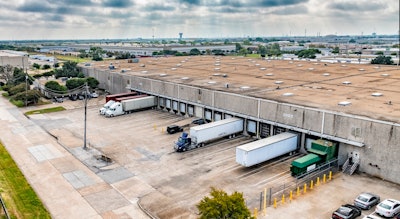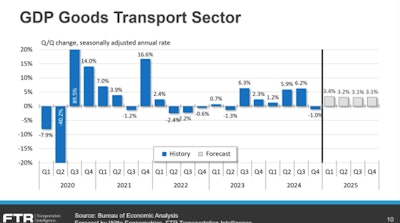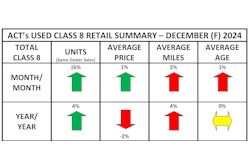
Rapid-fire changes from the Trump administration were the elephant in the room on Thursday's webinar from FTR: Transportation Intelligence. Vice President of Trucking Avery Vise says while the economic outlook doesn't directly address Trump's changing policies, it does show some of the effects.
The industrial sector, for instance, is in positive territory for the first time in 27 months, with new orders being the strongest of the sub-indices. As that is the sector that correlates the most with future freight demand, Vise says it's "a very positive sign." Tariffs may have affected some buying and manufacturing, Vise says, as the markets have anticipated them since Election Day.
"It is possible that some of the strength we've seen in the data we're seeing here is affected by tariffs," Vise says. He cautioned that while it seems that orders are at an inflection point, he would like to see sustained improvement for at least the next couple of months. Also possibly affected by tariffs are automotive sales, which ticked up slightly. Shrinking inventory-to-sales ratios are also a positive sign, Vise says.

Spending on durable goods is more complicated, Vise says.
"We have seen growth in most categories, at least to some degree, what has really driven growth in consumer spending is recreational goods and vehicles," Vise says, led by consumer electronics, which includes software and digital downloads, neither of which have much value as freight goods.
Industrial production is "positively robust" compared to previous forecasts, Vise says, with FTR predicting around 1% growth for 2025. An America First trade police could lead to more reshoring, eventually, Vise says, but the company doesn't think it's going to happen dramatically or quickly.
"We just don't expect any significant reshoring to actually take place," Vise says. "If we see reshoring, that's going to be more of a medium- or longer-term development."
Vise warns the Trump administration may be taking a more populist bent than his previous time in the White House. For instance, he nominated a labor secretary in Lori Chavez-DeRemer that is pro-union. Furthermore, a Trump executive order decrees that for every new regulation imposed, 10 more have to be undone.
"There's going to be a pretty high bar for new regulations," Vise says. It may be more simple to look at what could possibly go away. The expectation, Vise says, is the EPA's Phase 3 Greenhouse Gas regulations will go away or be pared back, and many of the electric truck initiatives appear to be in trouble.
[RELATED: When will the next Class 8 truck pre-buy start?]
"We do believe the EPA '27 rule (on NOx emissions) isn't nearly as likely to be undone as the greenhouse gas or electric vehicle rule," Vise says. Manufacturers have steadily worked toward compliance, and the deadline is close enough that only an act of Congress could change it.

For 2025, Vise sees a "stable" gross domestic product (GDP), with around 2% growth for the year. The GDP for the goods transport sector is a little stronger — around 3% growth for the year — but may carry some volatility as the year moves forward.
In individual trucking markets, Vise says the spot market "is not breaking any records," while refrigerated is still lagging year-over-year and flatbed is also behind on rates but ahead on volume.
"The overall freight market is much larger than the spot market," Vise says. "Overall, our forecast for 2025 is that we will be up 1.3%." Reefer, flatbed and tank will be stronger with dump and specialized coming in weaker.
"In general, though, all segments are looking at some level of recovery versus 2024," Vise says.

Vise's presentation also included a downward revision in the number of trucking jobs in the U.S. He says the drop of about 28,000 jobs should come as no surprise, as FTR pointed out since the middle of last year that data indicates a sharply weaker trucking sector than official figures. He says he reads the numbers as a job market bottoming out with a tightening of utilization. That's an encouraging sign for carriers, he says.
The bulk of that downward revision came in truckload jobs, with more than 22,000 jobs coming out of the sector, which is another signal that the market is bouncing along the bottom. LTL bucked the trend, being revised upward by 12,800 jobs, but was falling the last six months.
While there has been volatility in trucking jobs, capacity has remained fairly stable.
"Losing a carrier or adding a carrier is not the same as adding capacity," Vise says. Owner-operators or drivers who got their own authority are often moving back to payroll jobs. "It's really more of how the industry is structured. We've gotten a lot closer to a more typical pre-pandemic level of net entry and exit."
Total trucking employment is down 6.5% year-over-year with a 16.3% drop in non-payroll employment, the biggest drop since 2009.
"My argument is this," Vise says. "The issue isn't that we have a big capacity overage, overall. The issue is that level of capacity is much higher in the spot market working for brokers than it is for asset-based trucking companies or trucking companies using leased owner-operators. It's much more of an issue of where capacity is moreso than how much capacity there is."
Vise says FTR might see some increase in utilization, but not a dramatic one, topping out around 95% or 96%. Rates should also remain somewhat steady, with spot staying flat and contract hovering around 2% growth. Less-than-truckload contract rates should see around 1.5% growth.
"Not especially anything for carriers to get excited about or shippers to be overly concerned with," Vise says.











